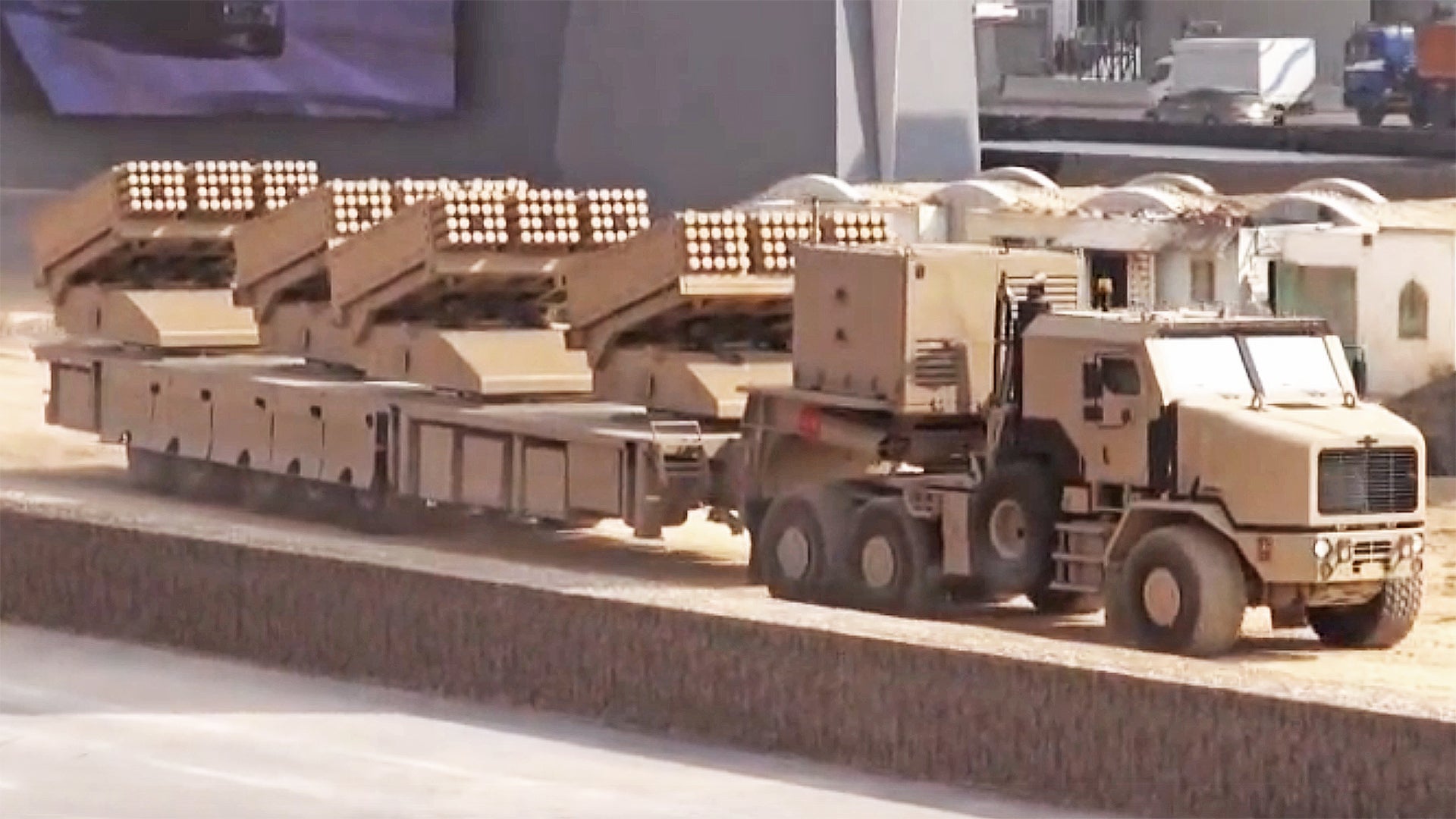It looks like it belongs on the G.I. Joe aisle of a toy store rather than on an actual battlefield, but there is no doubt the UAE’s Jobaria Defense Systems were thinking big when they designed their Multiple Cradle Launcher (MCL). The concept combines an Oshkosh M1070 Heavy Equipment Transporter with a 29-meter trailer outfitted with four multiple rocket launchers that hold 60 122mm rockets each. That’s a grand total of 240 rockets at the operator’s disposal and a whole lot of firepower for a single land combat system to bring to the table.
The main armament for the MCL is the Roketsan TR/TRB-122 Extended Range Artillery Rocket of Turkish origin. These rockets come in high-explosive and steel-ball warhead varieties, the latter of which sends thousands of steel balls flying at very high velocities after being detonated by proximity fuse. Nasty, nasty stuff. The high-explosive TR-122 has an effective radius of 20 meters, while the steel shot slinging TRB-122’s effective radius of double that. Both warheads weight about 40 pounds.

Both types of rockets have a range of roughly two dozen miles. The fact that MCL has 240 of them to play with means that the system can rain down incredible destruction over a huge area in a single volley, and putting a lot of ordnance on a target in a short amount of time is what short-range rocket artillery is all about.. The MCL’s advanced fire control system is totally automated and each rocket can be fired individually, or all of them at once in one giant salvo at roughly two rockets per second. As such, the operator can vary the pattern density and warhead choice depending on the target in mind.
For instance, to take out large formations of personnel and material scattered over a wide area, TRB-122 rockets can continuously blanket the widest area possible with hot shrapnel. If a highly localized group of structures or armored vehicles are the target, the system can be set to fire a string of high-explosive rockets over a small geographical area, pounding the target to pieces. A mix of both rockets can also be deployed for “mixed” effects.
The size of the MCL, although visually impressive, has some drawbacks and advantages. The UAE procured the system because it cuts manning requirements down to just one tenth that of a traditional rocket artillery unit that would require six individual vehicles and 30 people to deploy the same amount of firepower. Also by putting all those rockets into one integrated system, its ease of operation and tactical flexibility can be leveraged to adapt fast to battlefield demands and to create tailored effects on the fly. Even rearming the system is simplified, requiring just one support vehicle that can rearm the entire MCL’s magazine in about 30 minutes during wartime operations.

On the other hand, the MCL concept also presents a pretty large and unmaneuverable target to enemy forces. Unlike smaller truck-mounted rocket artillery that can speed about rough terrain and hide in many places, the lumbering MCL is far less survivable under certain circumstances. And if the MCL is successfully targeted, its 240 rocket payload can be wiped out by one strike. The relatively short-range of the rockets it carries also means the MCL will have to work in fairly close proximity to enemy forces. Still, the firepower and efficiency of the system is impressive, and for some sorts of warfare, such a protecting a country’s desert borders from attack, it make some sense.
Jobaria is in the process of making a longer-range, harder-hitting companion to the MCL, dubbed the Twin Cradle Launcher (TCL). The concept was shown off at this year’s IDEX weapons expo in Dubai. Instead of four launchers for hundreds of smaller artillery rockets, two sets of four massive 300mm rocket launch canisters are incorporated into the system’s trailer which is about eight meters shorter than the one used by the MCL.
This new system can supposedly accommodate two types of existing rockets. The Turkish-built TR/TRB-300 “Tiger” rockets, which have a range of up to 75 miles, or Chinese-built A300 rockets which have a range up nearly 180 miles. Either way, this system gives standoff capability that could help negative its size disadvantage. Although either of these rockets can be used against single targets or area targets, they do not possess the overwhelming area sanitization capability that the far shorter-range MCL offers.
Long-range guided artillery rockets have become especially popular in recent years, as their quick employment time and easy deployability can offer aerial precision attack-like capabilities in a much more persistent and inexpensive manner. The Army and Marine Corps’ HiMARS system, and its GPS guided 277mm rockets, have become an all star in Iraq, and is likely to become the same in Syria. Meanwhile, in the highly contested South China Sea, Vietnam quietly forward deployed the Israeli-made “EXTRA” long-range GPS guided rocket artillery system to one of their own islands in the disputed body of water—putting some of China’s man-made island outposts in range of sudden and highly accurate bombardment.
It is thought that the MCL, which was first unveiled in 2013, has been used operationally, most likely against Iranian-backed Houthi rebels in Yemen.
Hat tip to Task and Purpose for the video.
Contact the author: Tyler@thedrive.com
